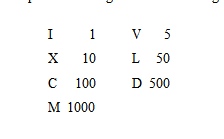3 人解决,7 人已尝试。
5 份提交通过,共有 17 份提交。
8.7 EMB 奖励。
单点时限: 2.0 sec
内存限制: 256 MB
The original system of writing numbers used by the early Romans was simple but cumbersome. Various letters were used to represent important numbers, and these were then strung together to represent other numbers with the values decreasing monotonically from left to right. The letters they used and the numbers that were represented are given in the following table.

Thus 1993 was written as MDCCCCLXXXXIII. This system was then superseded by a partially place-oriented system, whereby if the above rule of decreasing values was broken, it meant that the immediately preceding (lower) value was deemed to be `negative’ and was subtracted from the higher (out of place) value. In this system 1993 was usually written as MCMXCIII. There is still some controversy as to which letters could precede which other letters, but for the purposes of this problem we will assume the following restrictions:
1.
A letter from the left column can never appear more than three times in a row, and there can never be more than one other occurrence of that letter.
2.
A letter from the right column can never appear more than once.
3.
Once a letter has been used in a `negative’ position, all subsequent characters (apart from the one immediately following) may not be greater than that character.
Thus we could write MXMIII for 1993 or CCXCIV for 294, however we could not write ILV for 54, nor could we write LIL for 99. Note that 299 could be written as CCXCIX or CCIC
Given a Roman sum, we can either interpret it as such or as an encoding of an Arabic sum. Thus V+V=X could be interpreted as an ambiguous encoding of an Arabic sum with V {1, 2, 3, 4} and X = 2 * V. Similarly, X+X=XX could be interpreted as a correct Roman sum but an impossible Arabic encoding (apart from the trivial encoding X = 0) and XX+XX=MXC as an incorrect Roman sum, but a valid encoding with M = 1, X = 9, and C = 8.
Write a program that will read in sums in Roman numerals and determine whether or not they are correct as Roman sums and also whether they are impossible, ambiguous or valid as Arabic encodings. Assume that zero will never appear on its own or as a leading digit, and that no two Roman numerals map onto the same Arabic digit.
Input will consist of a series of lines, each line consisting of an apparent Roman sum, i.e. a valid Roman number, a plus sign (+), another valid Roman number, an equal sign (=) and another valid Roman number. No Roman number will contain more than 9 letters. The file will be terminated by a line consisting of a single #.
Output will consist of a series of lines, one for each line of the input, and each containing two words. The first word will be one of (Correct, Incorrect) depending on whether the Roman sum is or is not correct. The second word will be separated from the first by exactly one space and will be one of the set (impossible, ambiguous, valid) depending on the Arabic sum.
V+V=X X+X=XX XX+XX=MXC #
Correct ambiguous Correct impossible Incorrect valid
3 人解决,7 人已尝试。
5 份提交通过,共有 17 份提交。
8.7 EMB 奖励。